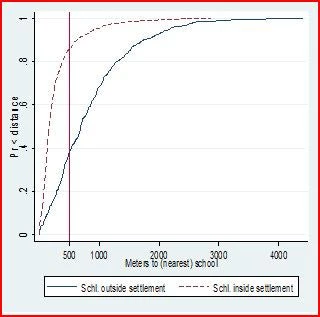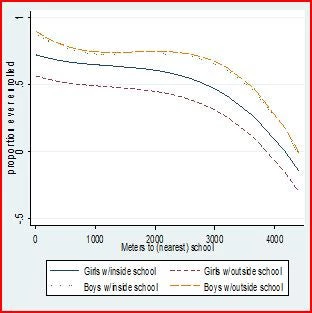Today's post comes from guest bloggers Hanan Jacoby and Ghazala Mansuri...
In thinking about why girls’ educational attainment is relatively low and has been slow to improve in many parts of south Asia, social scientists appeal to two kinds of arguments: (1) Parents have ingrained preferences favoring human capital investment in sons over daughters and/or (2) the economic returns to education remain substantially higher for males than for females.
But there is a third possible explanation: Social barriers that raise the cost or lower the benefit of attending school for certain groups. Indeed, social constraints can interact in surprising ways to limit educational opportunities for girls. In rural Pakistan, the custom of purdah or female seclusion restricts young girls’ access to public spaces, but is more rigidly enforced outside of the immediate community than within it. Less well known is the strong caste hierarchy, similar to that of India, with lower castes subject to discrimination and ostracism by higher castes, including within schoolhouse walls. The following excerpts from field interviews quoted in Jacoby and Mansuri (2011) are typical:
They let the daughters of [high castes] use the latrines, but tell our daughters to use the fields because you stink. (Low-caste woman, Southern Punjab)
The teachers make the daughters of [high castes] sit inside the rooms, under the fans. Our poor children sit outside, under the sun and dust." (Low-caste women, Southern Punjab)
Quantitative analysis corroborates this anecdotal evidence. Using novel data that explicitly recognizes the geographic structure of villages and the social structure of their constituent settlements, Jacoby and Mansuri (2011) find that the rate of enrollment in primary school is much lower for girls who have to cross settlement boundaries to attend, irrespective of the distance they would have to travel. This purdah effect is absent for boys.
However, once children are differentiated by their caste status, low-caste girls are found to be indifferent to settlement boundaries. This is because most low-caste children live in settlements dominated by high-caste households and thus face particularly high barriers to attending a local school, if one exists. Supporting this story is the finding that low-caste girls whose nearest school is located in a low-caste dominant community enroll at substantially higher rates than their counterparts without access to such schools—higher, in fact, than high-caste girls having schools in their own settlement! So, low-caste status per se does not seem to dampen parents’ educational aspirations for their children.
In light of these results, Jacoby and Mansuri go on to ask what kind of school building program would raise primary school enrollment rates in rural Pakistan most cost-effectively. Rather than providing a school to every settlement currently lacking one, targeting schools to low-caste dominant settlements is shown to deliver twice the overall enrollment impact at a sixth of the cost. Importantly, the targeted policy greatly increases primary school enrollment among the most socially excluded and hence educationally disadvantaged group: low-caste girls. This is good news given the difficulty of designing scalable policies that raise the returns to education.




Join the Conversation